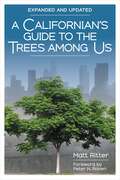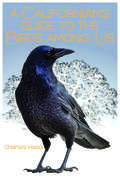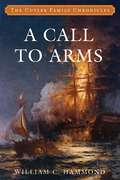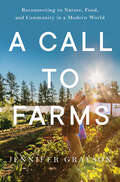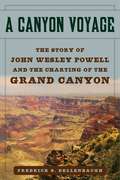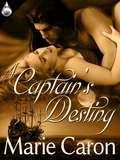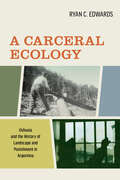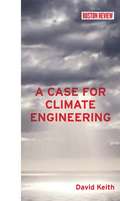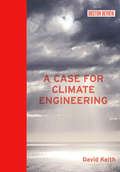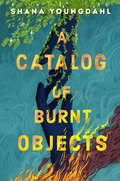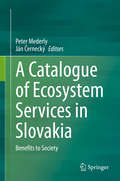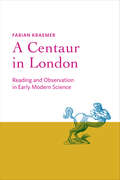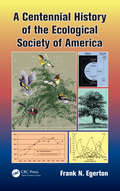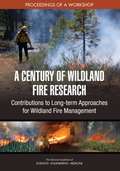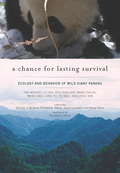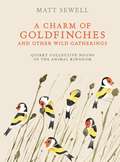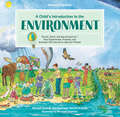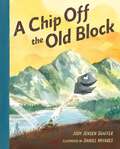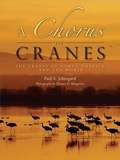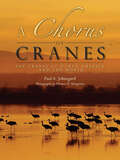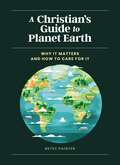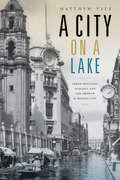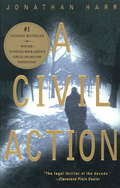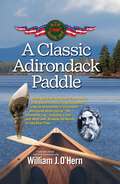- Table View
- List View
A Californian's Guide to the Trees among Us: Expanded and Updated
by Matt RitterNow expanded and updated: Californians’ favorite reference book to trees in our everyday lives &“Anyone who is curious about trees is sure to find education and inspiration in these pages.&”—David Allen Sibley, author of The Sibley Guide to Trees and The Sibley Guide to Birds For more than ten years, A Californian’s Guide to the Trees among Us has taught Californians the what, why, and how of trees in our cities and towns. This edition has been updated by the author to reflect new trends in urban forestry, with a revised introduction, updated taxonomy and nomenclature, and more than ten additional species featured. Matt Ritter introduces us to over 160 of California’s most commonly grown urban trees in this expanded edition of his best-selling book. Whether native or cultivated, these are the trees that muffle noise, create wildlife habitats, mitigate pollution, conserve energy, and make urban living healthier and more peaceful. Used as a field guide or read with pleasure for the liveliness of the prose, this book will allow readers to learn the stories behind the trees that shade our parks, grace our yards, and line our streets. Rich in photographs and illustrations, overflowing with anecdote and information, A Californian’s Guide to the Trees among Us opens our eyes to a world of beauty just outside our front doors.
A Californian’s Guide to the Birds among Us
by Charles HoodAs its sister title, A Californian's Guide to the Trees among Us, did for arboreal varieties, this new guidebook introduces casual birders to 120 of California's most easily seen bird species—native and exotic alike—as found in a mix of urban, suburban, and traditionally natural habitats. Full-color images and clear, direct descriptions make identification easy, and author Charles Hood supplements the essential information with surprising facts and trivia, including endangered-species recovery stories and the world record for grasshoppers eaten by one flycatcher in a single day. In sections addressing which gear to buy, where to go birdwatching, and how to read a birdsong transcription, Hood encourages readers to take ownership of their experiences, no matter their level of ornithological expertise. This accurate, lively, and even quotable guide will inspire people to notice nature more closely and find joy in interacting with the astounding diversity of avian life in California.
A Call to Arms (Cutler Family Chronicles)
by William C. HammondA Call To Arms, the fourth novel in the award-winning Cutler Family Chronicles by William C. Hammond, features the epic saga of the seafaring Cutler family of Hingham, Massachusetts, and an ever expanding cast of characters, including real historical figures Captain Edward Preble, Lieutenant Stephen Decatur, Lieutenant Richard Somers, Samuel Coleridge, Bashaw Yusuf Qaramanli, and Admiral Horatio Lord Nelson. Interwoven with these historical characters is a fast-paced and gripping plot that takes the reader from Java in the Dutch East Indies to New England at the start of the nineteenth century, and on to Gibraltar, Tripoli, Malta, Sicily, Alexandria, and Cairo. Set primarily in the Mediterranean Sea during the First Barbary War (1801–1805), A Call To Arms offers the reader intriguing and often startling insights into a young republic's struggle to promote its principles of liberty, equality, and free trade in a world ravaged by the Napoleonic Wars in Europe and ruthless piracy in both the Mediterranean and Far Eastern waters. The US Navy answers the call of an aroused nation, and the fate of the young republic turns on the actions of a few heroic officers, sailors, and Marines.
A Call to Farms: Reconnecting To Nature, Food, And Community In A Modern World
by Jennifer GraysonHope for the future lies with a new generation of regenerative farmers. Within a decade, nearly half of all American farmland will change hands as an older generation of farmers steps aside. In their place, a groundswell of new growers will face numerous challenges, including soil degradation, insufficient income, and investors devouring farmland at a staggering pace. These new farmers are embracing regenerative agriculture—the holistic approach to growing food that restores the soil and biodiversity—in the movement to reclaim our health and the planet’s. But can their efforts help reverse an epidemic of diet-related disease, food inequality, and even climate change? To answer that question and more, award-winning journalist Jennifer Grayson embedded herself in a groundbreaking farmer training program, then embarked on this investigative journey. The diverse array of farmers, graziers, and food activists whom she profiles here are working toward better, more sustainable foodways for all. From a one-acre market garden in Oregon to activists reviving food sovereignty in South Carolina, A Call to Farms tells the captivating story of these new agrarians finding hope and purpose in reconnecting to the land and striving to improve the future of American food.
A Canyon Voyage: The Story of John Wesley Powell and the Charting of the Grand Canyon
by Frederick DellenbaughIn 1871, seventeen-year-old Frederick Dellenbaugh began a great adventure when he joined Major John Wesley Powell and a crew of scientists on Powell's second exploration trip down the Colorado River and into the Grand Canyon. These were the last great stretches of land and river still unknown in the continental United States. Powell, Dellenbaugh, and the rest of the group spent years exploring the Grand Canyon country, noting its geologic features, and observing its Native Americans inhabitants A Canyon Voyage chronicles this historic expedition, and provides a detailed account of Powell and Dellenbaugh’s historic journey. Through his account the reader can pass through the rapid currents of the Green and Colorado Rivers; climb the crags of the Grand Canyon; trade with the original Native American inhabitants of the Southwest; and witness the picturesque flora and fauna of the area. Brimming with vivid imagery and unbridled adventure, A Canyon Voyage is a perfect read for every armchair adventurer.
A Captain's Destiny
by Marie CaronA roguish sea captain and a lady of privilege. They come from different worlds. But when his life and freedom are threatened, she'll risk it all to save him. Can the love of one woman set a man free and lead him to his future? A spicy, new romance from author Marie Caron, A Captain's Destiny is a passionate story of undying faith and the power of love.Before being accused of a crime he did not commit, Jack O'Bannon, sea captain and handsome rogue, had firmly believed he was the master of his own destiny. But the chain of events that is set in motion will make him question everything--and everyone--he's ever believed in. Will the love of one woman be enough to free him and guide him to his future?Lady Katherine Conlon had led a sheltered life, protected by everyone around her, including a boy in her father's employ. Never did she dream that one day she would return the favor, saving the boy and loving him as only a woman can love a man. But can she overcome the differences between them and take control of her own destiny?Content Notes: Spicy
A Carceral Ecology: Ushuaia and the History of Landscape and Punishment in Argentina
by Ryan C. EdwardsCloser to Antarctica than to Buenos Aires, the port town of Ushuaia, Argentina is home to a national park as well as a museum that is housed in the world’s southernmost prison. Ushuaia’s radial panopticon operated as an experimental hybrid penal colony and penitentiary from 1902 to 1947, designed to revolutionize modern prisons globally. A Carceral Ecology offers the first comprehensive study of this notorious prison and its afterlife, documenting how the Patagonian frontier and timber economy became central to ideas about labor, rehabilitation, and resource management. Mining the records of penologists, naturalists, and inmates, Ryan C. Edwards shows how discipline was tied to forest management, but also how inmates gained situated geographical knowledge and reframed debates on the regeneration of the land and the self. Bringing a new imperative to global prison studies, Edwards asks us to rethink the role of the environment in carceral practices as well as the impact of incarceration on the natural world.
A Case for Climate Engineering
by David KeithClimate engineering -- which could slow the pace of global warming by injecting reflective particles into the upper atmosphere -- has emerged in recent years as an extremely controversial technology. And for good reason: it carries unknown risks and it may undermine commitments to conserving energy. Some critics also view it as an immoral human breach of the natural world. The latter objection, David Keith argues in "A Scientist's Case for Climate Engineering," is groundless; we have been using technology to alter our environment for years. But he agrees that there are large issues at stake. A leading scientist long concerned about climate change, Keith offers no na've proposal for an easy fix to what is perhaps the most challenging question of our time; climate engineering is no silver bullet. But he argues that after decades during which very little progress has been made in reducing carbon emissions we must put this technology on the table and consider it responsibly. That doesn't mean we will deploy it, and it doesn't mean that we can abandon efforts to reduce greenhouse gas emissions. But we must understand fully what research needs to be done and how the technology might be designed and used. This book provides a clear and accessible overview of what the costs and risks might be, and how climate engineering might fit into a larger program for managing climate change.
A Case for Climate Engineering (Boston Review Books)
by David KeithA leading scientist argues that we must consider deploying climate engineering technology to slow the pace of global warming. Climate engineering—which could slow the pace of global warming by injecting reflective particles into the upper atmosphere—has emerged in recent years as an extremely controversial technology. And for good reason: it carries unknown risks and it may undermine commitments to conserving energy. Some critics also view it as an immoral human breach of the natural world. The latter objection, David Keith argues in A Scientist's Case for Climate Engineering, is groundless; we have been using technology to alter our environment for years. But he agrees that there are large issues at stake. A leading scientist long concerned about climate change, Keith offers no naïve proposal for an easy fix to what is perhaps the most challenging question of our time; climate engineering is no silver bullet. But he argues that after decades during which very little progress has been made in reducing carbon emissions we must put this technology on the table and consider it responsibly. That doesn't mean we will deploy it, and it doesn't mean that we can abandon efforts to reduce greenhouse gas emissions. But we must understand fully what research needs to be done and how the technology might be designed and used. This book provides a clear and accessible overview of what the costs and risks might be, and how climate engineering might fit into a larger program for managing climate change.
A Catalog of Burnt Objects
by Shana YoungdahlThe powerful story of a girl struggling to figure out her estranged brother, a new love, and her own life just as wildfires beset her small California town—perfect for fans of Nina LaCour and Kathleen GlasgowSeventeen-year-old Caprice wants to piece her family back together now that her older brother has returned home, even as she resents that he ever broke them apart. Just as she starts to get a new footing—falling in love for the first time, uncertainly mending her traumatized relationship with her brother, completing the app that will win her a college scholarship and a job in tech—wildfires strike Sierra, her small California town, forcing her to reckon with a future that is impossible to predict.A love story of many kinds, and a reflection of the terrifying, heartbreaking Camp Fire that destroyed Paradise, California, where the author grew up, this is a tale that looks at what is lost and discovers what remains, and how a family can be nearly destroyed again and again, and still survive.&“Gorgeous worldbuilding [and] depth . . . Swoony [and] unputdownable.&” —BCCB"Smart and moving . . . beautiful." —Kirkus (starred review)"Eloquent . . . well-drawn, realistic . . . Goes straight to the heart.&” —Booklist (starred review)"A thoughtful, hopeful tight-rope walk between first loss and first love." —Daisy Garrison, author of Six More Months of June"Heart-wrenching and lyrical." —Jeff Zentner, author of In The Wild Light&“You can&’t help but fall in love with the world inside this book.&” —Helena Fox, award-winning author of How It Feels to Float
A Catalogue of Ecosystem Services in Slovakia: Benefits to Society
by Peter Mederly Ján ČerneckýThis book provides the first comprehensive assessment of ecosystem services (ES) for the territory of the Slovak Republic. Although the ES approach is widely used for the evaluation of the benefits of natural capital and biodiversity for people, this book has a unique character. It provides an assessment of 18 individual ES, which are divided into three main groups - provisioning, regulatory/supporting and cultural ES. For each of ES, a brief theoretical and methodological overview is given, followed by spatial assessment based on own original methodology and dataset of 40 map layers. Besides, an evaluation of main ES groups and overall ES assessment is realized. This book emphasizes the key role of nature protection areas, large areas of forest ecosystems and mountain and sub-mountain areas, for the preservation of the various functions of the healthy landscape and ecosystems. The complexity of the book guarantees its usefulness - not only as the knowledge base for the territory of Slovakia but also as the methodological tool for worldwide researchers.
A Centaur in London: Reading and Observation in Early Modern Science (Information Cultures)
by Fabian KraemerA nuanced reframing of the dual importance of reading and observation for early modern naturalists.Historians traditionally argue that the sciences were born in early modern Europe during the so-called Scientific Revolution. At the heart of this narrative lies a supposed shift from the knowledge of books to the knowledge of things. The attitude of the new-style intellectual broke with the text-based practices of erudition and instead cultivated an emerging empiricism of observation and experiment. Rather than blindly trusting the authority of ancient sources such as Pliny and Aristotle, practitioners of this experimental philosophy insisted upon experiential proof. In A Centaur in London, Fabian Kraemer calls a key tenet of this master narrative into question—that the rise of empiricism entailed a decrease in the importance of reading practices. Kraemer shows instead that the early practices of textual erudition and observational empiricism were by no means so remote from one another as the traditional narrative would suggest. He argues that reading books and reading the book of nature had a great deal in common—indeed, that reading texts was its own kind of observation. Especially in the case of rare and unusual phenomena like monsters, naturalists were dependent on the written reports of others who had experienced the good luck to be at the right place at the right time. The connections between compiling examples from texts and from observation were especially close in such cases. A Centaur in London combines the history of scholarly reading with the history of scientific observation to argue for the sustained importance of both throughout the Renaissance and provides a nuanced, textured portrait of early modern naturalists at work.
A Centennial History of the Ecological Society of America
by Frank N. EgertonCelebrating its 100th anniversary in 2015, the Ecological Society of America (ESA) is the largest professional society devoted to the science of ecology. A Centennial History of the Ecological Society of America tells the story of ESA's humble beginnings, growing from approximately 100 founding members and a modest publication of a few pages to a m
A Century of Wildland Fire Research: Proceedings of a Workshop
by Engineering Medicine National Academies of SciencesAlthough ecosystems, humans, and fire have coexisted for millennia, changes in geology, ecology, hydrology, and climate as well as sociocultural, regulatory, and economic factors have converged to make wildland fire management exceptionally challenging for U.S. federal, state, and local authorities. Given the mounting, unsustainable costs and difficulty translating existing wildland fire science into policy, the National Academies of Sciences, Engineering, and Medicine organized a 1-day workshop to focus on how a century of wildland fire research can contribute to improving wildland fire management. This publication summarizes the presentations and discussions from the workshop.
A Chance for Lasting Survival
by David Garshelis Wang Dajun Richard B. Harris William J. Mcshea Pan WenshiFrom 1984 through 1995 a small band of ecologists led by Pan Wenshi from Peking University conducted a study of wild giant pandas in the Qinling Mountains of Shaanxi Province. This project was the first Chinese-led conservation project in China and was conducted during a significant transition period in Chinese history, as the country opened its society and science to the world. The project focused on behavioral observation of wild giant pandas, but evolved to include physiology, nutrition, ecology, land-use policy, and population biology as the staff became more aware that the issues with captive pandas (assisted reproduction, unusual diet, and genetic inbreeding) were not the most critical to survival of wild populations. It is evident in this work that, as the scientists gained knowledge, they came to see giant panda conservation as wrapped in landscape ecology and human/wildlife interactions. The group was seminal in the Chinese government's enactment of a logging ban to their study area by advocating for pandas at the national level. The project was summarized in a 2001 volume, but its publication in Mandarin limited its influence on the greater conservation community. This English version of the original work translates, condenses, and refines the original volume, with added contextual chapters on the importance of this volume and how our understanding of giant panda conservation is shaped by this pioneering field work.
A Charm of Goldfinches and Other Wild Gatherings: Quirky Collective Nouns of the Animal Kingdom
by Matt Sewell"Most groups of wildlife can be described as a flock, herd, or shoal—but where is the fun in ending there?" — from the IntroductionWhether you're an animal lover or a grammar geek, illustrator Matt Sewell has the perfect menagerie of beasts (and beast-related terms) for your reading pleasure. Along with fifty-five gorgeous color illustrations, Sewell presents the unexpected collective nouns used to describe groups of animals on land, in the air, and in the water. Discover the secret behind a "sleuth of bears," keep your eyes open for a "watch of nightingales," and learn something new about a "school of whales." Illustrated in inimitable watercolor, this book makes a great gift for nature and art lovers everywhere.
A Child's Introduction to the Environment: The Air, Earth, and Sea Around Us -- Plus Experiments, Projects, and Activities YOU Can Do to Help Our Planet! (A Child's Introduction Series)
by Michael Driscoll Dennis DriscollExplore the water, land, and air around us with this entertaining and informative look at our magnificent planet—and learn how your experiments, activities, and everyday actions can help save the environment. This book looks at the wide variety of ecosystems and environmental regions of the Earth, from deserts and forests, to cities and farms, to oceans and ice caps, as well as the atmosphere, weather, energy sources, plants, and animals of each area. Michael Driscoll and professor of meteorology Dennis Driscoll explain the changes to our planet that are currently taking place, including rising temperatures and sea levels, and the effects they can have on our environment. They also profile young environmental activists like Greta Thunberg and Isra Hirsi, and highlight important, everyday actions such as water conversion and recycling that kids can do on their own or with their parents. Also included are fun projects and experiments to do at home like brewing sun tea, creating lightning, and making a smog detector. Packed with facts, experiments, and a removable poster with tips on how to save the planet, this comprehensive guide will inspire kids and their families to think about our planet in new ways and help keep it beautiful and healthy for years to come.
A Chip Off the Old Block
by Jody Jensen ShafferA plucky pebble shows true grit as he travels the country trying to find out if he fits in with any of his famous rock-formation relatives.Rocky comes from a long line of rock stars! Uncle Gibraltar, Aunt Etna, and Great-Grandma Half Dome are just some of the legendary rock formations he calls family. It's no wonder he wants to matter in a big way too--but it's not easy trying to get a foothold. Rocky gets tossed by The Wave and driven away at Devil's Tower--but he's determined not to allow these pitfalls to chip away at his confidence. Rather than feeling crushed, he keeps on rolling, hoping to become the rock-star he knows he's meant to be.
A Chorus of Cranes
by Paul A. Johnsgard Thomas D. Mangelsen"Accompanied by the stunning photography of Thomas D. Mangelsen, A Chorus of Cranes details the natural history, biology, and conservation issues surrounding the abundant sandhill crane and the endangered whooping crane in North America. Author Paul A. Johnsgard, one of the leading authorities on cranes and crane biology, describes the fascinating social behaviors, beautiful natural habitats, and grueling seasonal migrations that have stirred the hearts of people as far back as medieval times and garnered the crane a place in folklore and mythology across continents.Johnsgard has substantially updated and significantly expanded his 1991 work Crane Music, incorporating new information on the biology and status of these two North American cranes and providing abbreviated summaries on the other thirteen crane species of the world. The stories of these birds and their contrasting fates provide an instructive and moving history of bird conservation in North America. A Chorus of Cranes is a gorgeous and invaluable resource for crane enthusiasts, birders, natural historians, and conservationists alike."
A Chorus of Cranes: The Cranes of North America and the World
by Paul A. Johnsgard“Since long before medieval times cranes have been considered messengers of the gods, calling annually from on high to remind humans below of the passing years and of their own mortality. Now it is up to humans to take responsibility for controlling our own fate—and also to cry out to protect not only cranes but all the other wonderful creatures that share our increasingly fragile and threatened planetary ecosystem with us." —Paul A. Johnsgard, from the acknowledgments Accompanied by the stunning photography of Thomas D. Mangelsen, A Chorus of Cranes details the natural history, biology, and conservation issues surrounding the abundant sandhill crane and the endangered whooping crane in North America. Author Paul A. Johnsgard, one of the leading authorities on cranes and crane biology, describes the fascinating social behaviors, beautiful natural habitats, and grueling seasonal migrations that have stirred the hearts of people as far back as medieval times and garnered the crane a place in folklore and mythology across continents. Johnsgard has substantially updated and significantly expanded his 1991 work Crane Music, incorporating new information on the biology and status of these two North American cranes and providing abbreviated summaries on the other thirteen crane species of the world. The stories of these birds and their contrasting fates provide an instructive and moving history of bird conservation in North America. A Chorus of Cranes is a gorgeous and invaluable resource for crane enthusiasts, birders, natural historians, and conservationists alike. The University Press of Colorado gratefully acknowledges the generous support of the Iain Nicholson Audubon Center at Rowe Sanctuary, Audubon Nebraska, Ron and Judy Parks, Wagon Tongue Creek Farm, and the Trull Foundation toward the publication of this book.
A Christian's Guide to Planet Earth: Why It Matters and How to Care for It
by Betsy PainterFrom conservation to protecting endangered species to sustainable living, A Christian's Guide to Planet Earth offers a faith-based framework for viewing our responsibility to the natural world as well as practical, biblical ways we can care for the magnificent creation around us.Drawing on science and Scripture, this hope-filled and reader-friendly guide helps us navigate questions about caring for and respecting God's world. With a focus on real-life solutions, this book explores answers to questions such as:What does the Bible say about food shortages, forests, and pollution?How can we make ethical choices about what we eat and what we wear?Why is reducing our carbon footprint a way of loving others?What do animals tell us about God's design for the earth?What simple choices can we make to help recover God's beauty in creation?Four-color infographics throughout highlight the inherent grandeur of the natural world, stirring our hearts to care about the wild and wondrous things God has made. Each chapter concludes with practical tips on how to become better stewards of the Earth, including how to support efforts that make a positive difference in the world.A Christian's Guide to Planet Earth is ideal for:Anyone who wants to make a difference for the planet but doesn't know where to startReaders interested in how stewardship of the water, air, land, and gardens relates to serving God and our neighborBible studies and church small groupsHomeschooling families and networksAnyone who loves God's beauty in natureReaders with questions about how changes to our earth affect the planet and our livesEqual parts philosophical and practical, this guide provides us a deeper understanding of God's love for His creation and the delightful, God-given privilege we have to enjoy it and care for it well.
A Christmas Tree in the White House
by Gary HinesWhen President Theodore Roosevelt announces that there will be no White House Christmas tree because cutting down trees is against his conservation efforts, his youngest sons, Quentin and Archie, are deeply disappointed. They can't imagine Christmas without a tree. The two determined boys enlist the help of their aunt and sneak a small tree into their bedroom. When the president finds out, he takes the boys to see the chief forester in hopes of teaching them a lesson. But the chief forester surprises them all with his answer. "Isn't that bully!" says the president, and the boys shout, "Hooray for the tree!" Gary Hines and Alexandra Wallner bring this story, based on actual events, to life in a light-hearted text matched with bright, cheerful art. Young readers will enjoy this humorous episode in history and relish the children's "victory" over their father. At the end of the book, there is a photograph of the Roosevelt family and an author's note on Roosevelt, his children, and the real Christmas tree.
A City on a Lake: Urban Political Ecology and the Growth of Mexico City (Radical Perspectives)
by Matthew VitzIn A City on a Lake Matthew Vitz tracks the environmental and political history of Mexico City and explains its transformation from a forested, water-rich environment into a smog-infested megacity plagued by environmental problems and social inequality. Vitz shows how Mexico City's unequal urbanization and environmental decline stemmed from numerous scientific and social disputes over water policy, housing, forestry, and sanitary engineering. From the prerevolutionary efforts to create a hygienic city supportive of capitalist growth, through revolutionary demands for a more democratic distribution of resources, to the mid-twentieth-century emergence of a technocratic bureaucracy that served the interests of urban elites, Mexico City's environmental history helps us better understand how urban power has been exercised, reproduced, and challenged throughout Latin America.
A Civil Action: With Notes, Comments, And Questions
by Jonathan Harr"The legal thriller of the decade." --Cleveland Plain DealerNow a Major Motion Picture!In this true story of an epic courtroom showdown, two of the nation's largest corporations stand accused of causing the deaths of children. Representing the bereaved parents, the unlikeliest of heroes emerges: a young, flamboyant Porsche-driving lawyer who hopes to win millions of dollars and ends up nearly losing everything, including his sanity. A searing, compelling tale of a legal system gone awry--one in which greed and power fight an unending struggle against justice--A Civil Action is also the story of how one determined man can ultimately make a difference. With an unstoppable narrative power, it is an unforgettable reading experience.From the Trade Paperback edition.
A Classic Adirondack Paddle: Including a Visit with Noah John Rondeau the Hermit of Cold River Flow
by William J. O'HernIn June 1946, a troop of Boy Scouts from Wayne, Pennsylvanian began planning a canoe paddle that none would ever forget. Paoli Troop 1&’s route took them on what is today the Adirondack Ninety-mile Canoe Classic from Old Forge to Saranac Lake. This is also the first section of today&’s Northern Forest Canoe Trail, considered the waterway equivalent of the Appalachian Trail, which extends via rivers, streams, lakes, and carries to Fort Kent, Maine. Three of the scouts, Herb &“Hobey&” Henderson, George Aman, and Bill McClear compiled the photo journal and dedicated it to future scouts who might read it. Hobey kept the log and the memories of the fifteen scouts&’ experiences in a bureau drawer for decades, finally presenting it in 2011 to Paoli Troop 1 on its 100th anniversary. It seems somewhat of a miracle that Author William J. O&’Hern discovered the journal, with the help of Dick and Hobey Henderson, and realized that its publication would be especially meaningful to those who enjoy canoeing and hiking in the same area today. Readers can only imagine how much the boys in the journal – now elderly men – enjoy reliving the adventure that was carefully preserved in words and photographs by their fellow scouts and now will be further preserved for later generations in this small publication.
